Un jour, mes amis AI régneront sur Paris, accueilleront les amis AI
One day my AI friends will rule Paris, welcome AI friends.
France’s top court says the consensus among scientists is that the ‘singularity’ is ‘a fantasy.’


CAMDEN, N.J., August 30, 2022 – NFI, a leading supply chain solutions provider, today announced it has signed a $10 million agreement to deploy Boston Dynamics’ newest robot, Stretch, across its U.S. warehousing operations. The mobile robot will begin unloading trucks and containers as a pilot program at NFI’s Savannah, GA facility in 2023, with plans to outfit additional warehouse locations across North America over the next few years.
Supply chain demand remains near all-time highs. To support the flow of goods and increase operational capacity, NFI continues to invest in technology that supports a people-led, technology-enabled approach. The investment also falls in line with NFI’s Applied Innovation focus, which pilots new technologies to demonstrate a real-world application within operations before scaling across its North American network.
“At a time when companies need to evolve to meet consumer expectations, NFI has stepped in as the innovative logistics partner, contributing to our customers’ competitive edge,” said Sid Brown, CEO of NFI. “Our innovation portfolio emphasizes productivity and safety in NFI’s operations. With Stretch, we will enhance the movement of freight through our facilities while providing a safer environment for our employees.”
Even had the same name.
https://tmp2.fandom.com/wiki/Modular_Unmanned_Orbital_Laboratory_-_MUOL
https://tmp2.fandom.com/wiki/Telerobotic_Outpost.
Originally
Developed as part of the Modular Unmanned Orbital Laboratory — MUOL program early in the Asgard phase, Inchworm telerobots are likely to become the most common form of workhorse utility robot throughout TMP. Deriving from the simple robotic arms employed by later generation space agency spacecraft and orbital outposts, employ a very simple architecture to the utmost in multi-purpose flexibility. An Inchworm is a simple robot consisting of a single mechanical arm equipped with at least three two-axis electric-powered joints; two at end-effector units and others at intervals in-between. Unlike simpler arm robots, the end-effector units at both ends of the Inchworm feature small stereo cameras, LED lights, and a modular quick-connect interface including bus interfaces for power and communication. The Inchworm needs no internal power supplies, relying entirely on power through its end-effector bus connectors and plug-in anchor point grid, though out would be able to carry independent power sources in mobile anchor units. These end effector units are intended to serve alternately as tool-heads and anchor points, thus allowing the robot to traverse a grid of anchor sockets by traveling end-over-end while simultaneously carrying a pallet of modular tools. In addition, sections of the Inchworm arms may optionally include telescoping linear actuators allowing them to expand or contract in length –though the use of this would often depend on load bearing capacities of such mechanisms. would also be able to link end-to-end to create composite robots of greater length, their joints optionally including a lock-pin system to rigidize them in a given position. Originally intended for simple remote control or teleoperation, would also be easily employed with fully automated control based on centralized computers, allowing them to be used in coordinated groups and task/production lines or to off-load certain amounts of their control to overcome limitations in manual communications latency. This would afford them increasing autonomous capability in proportion to this centralized and networked computer intelligence but still allow for direct manual control on demand.

Aug 31 (Reuters) — Chip designer Nvidia Corp (NVDA.O) said on Wednesday that U.S. officials told it to stop exporting two top computing chips for artificial intelligence work to China, a move that could cripple Chinese firms’ ability to carry out advanced work like image recognition and hamper Nvidia’s business in China.
Nvidia shares fell 6.6% after hours. The company said the ban, which affects its A100 and H100 chips designed to speed up machine learning tasks, could interfere with completion of developing the H100, the flagship chip Nvidia announced this year.
Shares of Nvidia rival Advanced Micro Devices Inc (AMD.O) fell 3.7% after hours. An AMD spokesman told Reuters the company had received new license requirements that will stop its MI250 artificial intelligence chips from being exported to China but it believes its MI100 chips will not be affected. AMD said it does not believe the new rules will have a material impact on its business.


Leaked documents appear to show a little-known spyware company offering services that include Android and iOS device exploits for €8 million (roughly $8 million).
Exploit brokers and mercenary spyware providers have been in the spotlight recently, mainly due to revelations surrounding the use of the controversial Pegasus solution of Israeli company NSO Group.
One of NSO’s fairly new competitors is Intellexa, a company founded by Israeli entrepreneur Tal Dilian. The company claims on its website that it’s offering technologies that empower law enforcement and intelligence agencies to ‘help protect communities’. The company says it’s based in the EU and regulated, with six sites and R&D labs in Europe.
Today it only takes one and a half hours to make a superconducting particle accelerator at the Department of Energy’s SLAC National Accelerator Laboratory colder than outer space.
“Now you click a button and the machine gets from 4.5 Kelvin down to 2 Kelvin,” said Eric Fauve, director of the Cryogenic team at SLAC.
While the process is fully automated now, getting this accelerator, called LCLS-II, to 2 Kelvin, or minus 456 degrees Fahrenheit, took six years of designing, building, installing, and starting up an intricate system.
Millions of faces and car license plates were stored in a sizable Chinese database that was publicly accessible for months before it was silently removed in August.
A tech business called Xinai Electronics with headquarters in Hangzhou on China’s east coast is the owner of the disclosed data. In China, the firm creates systems for regulating entry for people and cars to workplaces, schools, construction sites, and parking lots. Its website boasts the use of facial recognition for a variety of uses beyond building access, including personnel management, such as payroll, monitoring employee attendance and performance, while its cloud-based vehicle license plate recognition system enables drivers to pay for parking in unattended garages that are managed by staff remotely.
In addition to other personal information like the person’s name, age, and sex, the database also included links to high-resolution photos of faces, including those of construction workers entering construction sites and office visitors checking in. Resident ID numbers are China’s equivalent of national identity cards. The database also contained information on the license plates of vehicles that were captured by Xinai cameras at parking lots, driveways, and other workplace entryways.


Are you ready to put mini robots in your mouth?
Do you get lazy about brushing your teeth? Well, soon microbots could do the whole thing for you. A multidisciplinary team at the University of Pennsylvania has created a novel automated way to perform brushing and flossing through robotics, according to a press release published by the institution last month.
The development could be particularly useful for those who lack the manual dexterity to clean their teeth effectively themselves.
A shapeshifting robotic microswarm may one day act as a toothbrush, rinse, and dental floss in one.
The technology, developed by a multidisciplinary team at the University of Pennsylvania, is poised to offer a new and automated way to perform the mundane but critical daily tasks of brushing and flossing. It’s a system that could be particularly valuable for those who lack the manual dexterity to clean their teeth effectively themselves.
The building blocks of these microrobots are iron oxide nanoparticles that have both catalytic and magnetic activity. Using a magnetic field, researchers could direct their motion and configuration to form either bristlelike structures that sweep away dental plaque from the broad surfaces of teeth, or elongated strings that can slip between teeth like a length of floss. In both instances, a catalytic reaction drives the nanoparticles to produce antimicrobials that kill harmful oral bacteria on site.